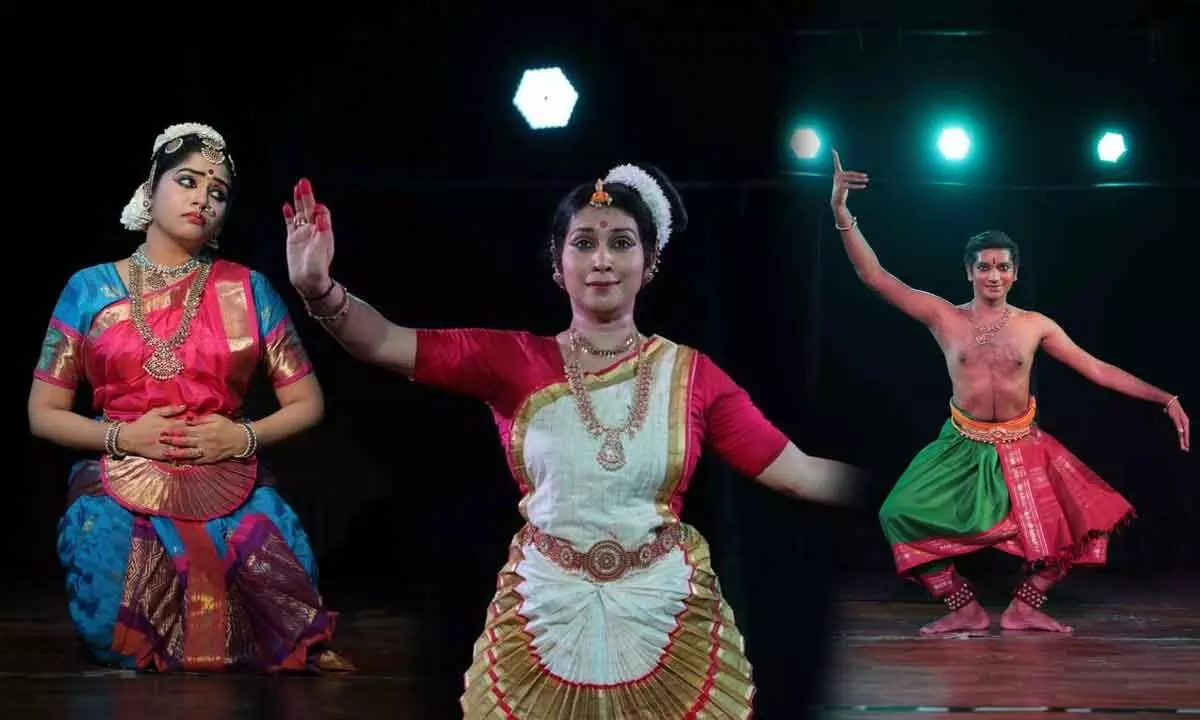Live
- Russell stunned with pole in Las Vegas, says 'Got to deep dive into why we’re so quick'
- BJP hijacked electoral machinery for securing victory in Maharashtra: Cong
- Guwahati to host Indian National Rally Sprint Championship on Sunday
- Priyanka will now be seen in Wayanad more often: Robert Vadra
- Cong won all 3 seats on basis of guarantees, development: Dy CM on K’taka bypolls
- Santosh Trophy: Odisha rout Chhattisgarh to make final rounds
- BJP hijacked electoral machinery for securing victory in Maharashtra: Cong
- Formula 1: Russell pips Sainz to take pole in Las Vegas GP
- India under Trump 2.0 could bolster its position in global supply chains
- People voted for ideology, rejected dynasty: Sudhanshu Trivedi on Maha victory
Just In
Abhyudaya Utsav: A celebration of classical dance


Guru Subbulakshmi Rana, a Bharatanatyam Teacher, is the founder of “Nrithyashala,” a Bharatanatyam institute. She is an alumna of Kalakshetra,...
Guru Subbulakshmi Rana, a Bharatanatyam Teacher, is the founder of “Nrithyashala,” a Bharatanatyam institute. She is an alumna of Kalakshetra, presently pursuing her Doctorate in dance. She has taken on the task of arranging an annual festival to bring a scintillating lineup of mostly solo artistes onstage in Begumpet. Kudos are deserved for this idea of hosting both Hyderabad dancers as well as those from other cities. The third “Abhyudaya Utsav” on Sunday was a great success.
The ensemble of Nrityashala, consisting of young students, presented a pushpanjali followed by alarippu. A jatiswaram in Arabhi completed the initial items, and the main varnam then followed. This was the famous flagship, “Manavi,” in Shankarabharanam by the Tanjore Quartet in the Kalakshetra interpretation, done by generations of dancers and well-rendered by these young artistes. The jathis punctuating were elaborate, and the mastery demonstrated was impeccable. Lord Brihadeeswara dwelling in the sacred town of Tanjore is entreated to show compassion, being the Nayika’s Lord. He is beseeched to listen to the loving prayers which keep his beauty and regal majesty in mind and shed his indifference. The five Arrows of Cupid have pierced the heart for the Lord who is beyond comparison.
Dr. Sathya Nemani then took the stage. The traditional Chokkessar kauthvam in Ganaragamalika is rather rarely seen. Shiva is eulogised as Chokkanatha of Madurai, who wears the Skins of Elephants and Tigers; destroyer of the Tripuras in their aerial Cities and who himself arrived to assist in preventing floods. Some dramatic stories depicting episodes involving Saiva Saints were also included. The Bharatanatyam dancer’s teermanams and adavus were precisely done in the intricate nritta designs which brought out her internalisation of the majestic piece magnificently. Her grip was impressive in this composition which requires a lot of stamina to render.
Next was the charming “Madu Meykkum Kanne,” a dialogue between little Krishna and his mother Yashoda. Sathya shone in this piece as she alternated between playing both roles, as Yashoda does not wish her little darling to go out but stay at home where she promises to give him treats. Krishna responds that he would rather herd the Cows and return soon so she should not worry. Thieves and wild animals are envisaged by the mother to threaten her child but again she is reassured that he knows how to deal capably with any trouble that may arise. She was a confidently assertive Krishna as well as a worried motherly Yashoda in aptly done abhinaya expressions emoting convincingly in both characterisations holding the spectators’ attention in thrall. Khamas thillana concluded her recital.
Dr Mythili Anoop is both a scholar with numerous publications to her credit as well as an accomplished Mohiniyattam dancer. The delicately nuanced art form from Kerala was exhibited with wonderful elegance and grace in three items. Ganga Tatvam celebrates and crafts the sacred River’s epitome. Draupadi’s padam from Duryodhana Vadham contains the episode of the miraculous Akshayapatra being empty as it cannot function once she has eaten but due to the intervention of Krishna who finds a single rice grain and eating it is satiated thus satisfying Sage Durvasa who with his disciples has arrived at this inconvenient time to test her; also, her reminder that her humiliation has to be avenged before any compromise is sought for displaying her unkempt hair and hamir kalyani thillana. The precisely measured riverine movements of her hands in exquisitely controlled hasthabhinaya brought on stage as it were the flowing rivulets and torrential gush of the holy River. Both dramatisation in abhinaya and mood when she donned the poignantly sublime role of Draupadi as well as the more lyrical liquidly flowing movements in nritta embedded in the thillana were surpassingly done as expected from a senior artiste. The interlude of a different classical dance style enabled the audience to appreciate both the gentle languorous beauty of Mohiniyattam as well as the comparatively staccato crystalline sparkle of Bharatanatyam.
K P Rakesh, a solo Bharatanatyam artiste, presented the last part of the program. He started with a kouthvam on Lord Muruga depicting the elder Son of Lord Shiva which was competently done. The varnam centrepiece portrayed the nine emotions of the Goddess ranging from her display of valour as Meenakshi to her expression of shringara or love when meeting her Consort on Mount Kailasa. Impressively articulated in the pure dance portions as well as colourfully episodic in the narrative part it was exhilarating with the brisk energy displayed capturing the audience. The ashtapadi, a choreographic masterpiece of Smt. Bragha Bessel, successfully brought alive Krishna’s pining desire for Radha—her Lotus Feet always bedecked with Anklets are placed on tender Leaves for comfort after long travail; Face lovely as the Moon and Nectar sweet conversation set aflame the body of Krishna with the Fire of love. All the shades of rasa present here were movingly brought out with consummate ease by Rakesh to applause as he concluded.

© 2024 Hyderabad Media House Limited/The Hans India. All rights reserved. Powered by hocalwire.com






